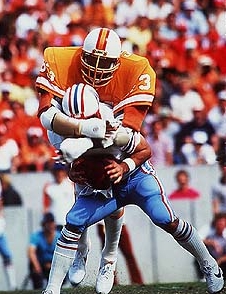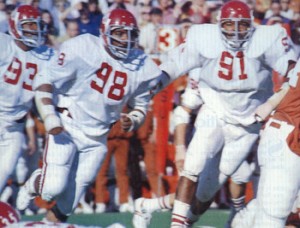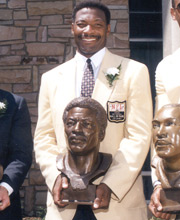Lee Roy Selmon Towered Over Tampa Bay Football
When the Tampa Bay Buccaneers joined the NFL in 1976 with their creamsicle colored uniforms and comical play on the field, they needed someone with credibility to signal to the rest of the league that while they might dress funny and make a lot of bad plays, they were a football team and they were out there trying to create a winner. That someone was the first player ever drafted by the Buccaneers, defensive lineman Lee Roy Selmon.
His death over the weekend following a stroke begs the recollection of the beginning of professional football in Tampa when the Buccaneers went from being a laughing stock to forging a level of respectability by winning two division titles and reaching the playoffs three times in a four year stretch.
For anyone (like me) who grew up on NFL Films, the early years of the Buccaneers can be summed up with two images from the vaults of video past. The first is of whimsical head coach John McKay expressing that he was in favor of his teams’ execution and the second of the 6-foot-3, 256 pound Selmon looking significantly larger than his listed size as he smothers an opposing quarterback.
The best of the three Selmon brothers (Lucious and Dewey were the others), Selmon excelled on and off the field as the University of Oklahoma won consecutive national titles in 1974 and 1975. He won the Outland and Lombardi Trophies and was also an Academic All-American.
After playing for one of the most successful programs in college football, he joined an NFL team that was destined to set a record for futility.
As the first draft pick in the 1976 NFL Draft, Selmon became the first draft pick of the Buccaneers. His brother, Dewey, was selected in the second round and would spend five years in Tampa.
Even though injuries limited Selmon to only eight games as a rookie, it is doubtful his presence would have made a significant difference as the Buccaneers lost all 14 games in their initial season. They tacked on 12 straight losses in their second season to set a new record with 26 straight losses.
However, while the Buccaneers were still not close to respectability, Selmon was starting to make his mark. He recorded a career-high 13 sacks in 1977 and by 1979 was recognized as an All-Pro.
It was in that surprising fourth season of the Buccaneers that the beleaguered team rose from the ashes to a surprising trip to the NFC Championship Game.
The Buccaneers won their first five games and then held on to win the division with a 10-6 record. The decisive 10th win came following a three-game losing streak and was a 3-0 victory over the Kansas City Chiefs during a Florida downpour that left the field nearly unplayable.
However, it proved the perfect statement for the unconventional Buccaneers. Though much of the publicity in 1979 went to young quarterback Doug Williams, it was Selmon and the defense that made Tampa Bay a winner. They led the NFL by allowing only 14.8 points per game while allowing the fewest passing yards in the league.
After surprising the Philadelphia Eagles in their opening playoff game, the Buccaneers appeared poised for an improbable trip to the Super Bowl as Selmon and the defense allowed Los Angeles only nine points in the NFC Championship Game. Unfortunately, the offense couldn’t muster a single point as the dream fell just short.
After a down season in 1980, which happened to be Dewey’s last season with the team, the Buccaneers again won the NFC Central in 1981 and then posted a 5-4 record and made another playoff appearance during the strike-shortened 1982 campaign.
However, that proved to be the high-water mark for the Buccaneers until the late 1990s when another squad built on defense eventually took the team to a Super Bowl title.
Selmon was long-gone by then as injuries halted his stalwart career following the 1984 season. In nine seasons, Selmon made six trips to the Pro Bowl while registering 78.5 sacks in 121 career games.
In 1995 he became the first Tampa Bay Buccaneer player to be inducted into the Pro Football Hall of Fame. While it shouldn’t be too many years before he is joined by Derrick Brooks, Warren Sapp and potentially others from the great teams of the late 1990s and early 2000s, he will likely always remain the lone Hall of Famer from the early years of the Buccaneers.
After his playing days, Selmon served as the Director of Athletics at the University of South Florida and helped them start football and eventually grow the sport into a successful Bowl Championship Subdivision squad. It was fitting that the day after his stroke, the Bulls registered one of the most significant victories in franchise history with a 23-20 win over Notre Dame.
Because he played on a team considered to be a laughing stock by many across the country and had his career shortened to just nine seasons due to injuries, Selmon may never have been considered by most to be one of the all-time greatest players in NFL history, but his presence towered over the Tampa Bay area at a time when football greatness wasn’t part of the lexicon and he will always be remembered as the player that set the table for football glory in Tampa Bay.












